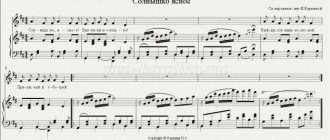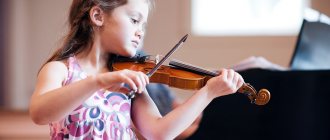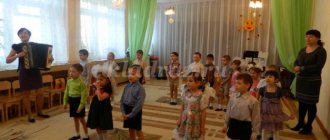Diagnostics of musical abilities work program on the topic
DIAGNOSTICS OF MUSICAL ABILITIES
in the preparatory group
September of the year
| № | F.I. child | Ladovoe feeling | Musical and auditory performance. | Feeling rhythm | Total | General level | |||||||||
| 1 | 2 | 3 | 4 | 1 | 2 | 3 | 4 | 1 | 2 | 3 | 4 | ||||
High level 36 points
closer to high 27-34
Average level 24 points
closer to low 13-20
Low level 12 points
May year.
| № | F.I. child | Ladovoe feeling | Musical and auditory performance. | Feeling rhythm | Total | General level | |||||||||
| 1 | 2 | 3 | 4 | 1 | 2 | 3 | 4 | 1 | 2 | 3 | 4 | ||||
Tasks for diagnosing children's musical abilities
In the preparatory group.
Beginning of the year.
Fret feeling
Task No. 1: Listen to the anthem of the Russian Federation, determine the general mood, the nature of the work, highlight individual means of expression: tempo, dynamics, timbre, determine instrumental accompaniment.
“3” - listens carefully to the piece from beginning to end, bright
external impressions, clearly expresses his thoughts, can identify means of expression and hears accompaniment instruments.
“2” - listens inattentively, is distracted, but can determine the character and highlight means of expression.
“1” - no interest, cannot cope with the task.
Task No. 2: Listen to the plays “The Doll’s Disease”, “The New Doll” by P.I. Tchaikovsky, invite the child to choose a picture from the proposed ones that are most suitable for the sound of the pieces, and motivate his choice. The ability to hear visual moments in music and relate them to a visual image is assessed.
“3” - listens carefully to the plays, can identify visual means and selects the picture most accurately.
“2” - does not listen carefully, is distracted, but can tell about the character and chooses the right picture.
“1” - no interest, almost do not react to plays.
Task No. 3: Using the didactic game “Ringing Bells”, identify the parts of a musical work..
“3” - listens attentively to the music. fragments, identifies parts correctly, lays out cards correctly.
“2” - listens inattentively, is distracted, but can identify parts of the play..
“1” - no interest, completes the task incorrectly.
Task No. 4: Listen and determine to which genre the listened piece belongs (march, dance, lullaby in orchestral arrangement), and on what instrument it is performed.
“3” - listens carefully to fragments of orchestral works, determines the genre and identifies the instruments.
“2” - listens inattentively, but can determine the genre of a piece of music and name selective instruments.
“1” - no interest, completes the task incorrectly.
The end of the year
Fret feeling
Task No. 1: Recognize the anthem of the Russian Federation from the introduction, determine the general mood, the nature of the work, highlight individual means of expression: tempo, dynamics, timbre, determine instrumental accompaniment.
“3” - recognized the hymn from the introduction, listens carefully to the work from beginning to end, vivid external impressions, clearly expresses his thoughts, can determine the means of expression and hears the accompanying instruments.
“2” - listens inattentively, learned from a hint, but can determine the character and identify means of expression.
“1” - no interest, cannot cope with the task.
Task No. 2: Listen to “Summer” by A. Vivaldi, invite the child to choose a picture from those proposed that is most suitable for the sound of the work and come up with a fairy tale based on a visual image and a musical one. The ability to hear visual moments in music and relate them to a visual image is assessed.
“3” - listens carefully to plays, can identify visual means and most accurately selects a picture, easily comes up with the plot of a fairy tale.
“2” - does not listen carefully, is distracted, but can tell about the character and correctly selects the picture, invents a fairy tale with the help of an adult.
“1” – no interest, almost no reaction to the work.
Task No. 3: Using the didactic game “Ringing Bells”, identify the parts of a musical work..
“3” - listens attentively to the music. fragments, identifies parts correctly, lays out cards correctly.
“2” - listens inattentively, is distracted, but can identify parts of the play..
“1” - no interest, completes the task incorrectly.
Task No. 4: Listen and determine to which genre the listened piece belongs (march, dance, lullaby in orchestral arrangement), and on what instrument it is performed.
“3” - listens carefully to fragments of orchestral works, determines the genre and identifies the instruments.
“2” - listens inattentively, but can determine the genre of a piece of music and name selective instruments.
“1” - no interest, completes the task incorrectly.
Beginning of the year.
Musical and auditory performance.
Task No. 1: Name your favorite song, motivate the choice, perform it exactly after the introduction to musical accompaniment. Identify parts of a song
“3” - sings, purely intoning the movement of the melody, performs the task correctly.
“2” - sings, not exactly, gets distracted, but hears the end of the introduction, doesn’t identify the parts.
“1” – no intonation, not exact text.
Task No. 2: Perform a short song without accompaniment, in a comfortable range.
“3” - sings, purely intoning the movement of the melody.
“2”—sings, not accurately, gets distracted, needs help from an adult.
“1” - no intonation, inaccurate text, many pauses.
Task No. 3: Determine the number of simultaneously sounding sounds “How many of us are singing?” Behind the screen I play two instruments at once and perform a familiar song with my voice.
“3” - names correctly, identifies instruments by sound, sings, purely intoning the movement of the melody.
“2” - he names it correctly, but the song doesn’t work.
“1” - cannot name the instruments, hits the hammer chaotically, indiscriminately.
Task No. 4: Name the proposed instruments (metallophone, tambourine, drum, etc.), show techniques for playing various instruments, play the song “The Blue Sky” in small groups and one at a time..
“3” - names correctly, masters playing techniques, performs the song along with singing. sings, purely intoning the movement of the melody.
“2” - names correctly, knows the techniques of playing, but the song does not work.
“1” - cannot name the instruments, hits the hammer chaotically, indiscriminately.
The end of the year
Musical and auditory performance.
Task No. 1: Name your favorite song, motivate the choice, perform it exactly after the introduction to musical accompaniment, and use the manual to lay out a diagram of the song.
“3” - sings, purely intoning the movement of the melody, performs the task correctly.
“2” - sings, not accurately, gets distracted, but hears the end of the introduction, cannot complete the task.
“1” – no intonation, not exact text.
Task No. 2: Repeat individual sounds of a small familiar song from the teacher’s voice, come up with a new ending for it.
“3” - sings, purely intonating the movement of the melody, fulfills the task with pleasure.
“2” - sings, not exactly, cannot come up with an ending without the help of an adult.
“1” - no intonation, inaccurate text, many pauses.
Task No. 3: Determine the number of simultaneously sounding sounds “How many of us are singing?” Behind the screen I play two instruments at once and perform a familiar song with my voice.
“3” - names correctly, identifies instruments by sound, sings, purely intoning the movement of the melody.
“2” - he names it correctly, but the song doesn’t work.
“1” - cannot name the instruments, hits the hammer chaotically, indiscriminately.
Task No. 4: Name the proposed instruments (metallophone, tambourine, drum, etc.), show techniques for playing various instruments, offer to independently choose a familiar song on the metallophone. Perform simple songs solo and in an ensemble on children's musical instruments.
“3” - names correctly, knows the techniques of the game, completes the task, with the support of an adult.
“2” - names correctly, knows the techniques of playing, but the song does not work.
“1” - cannot name the instruments, hits the hammer chaotically, indiscriminately.
Beginning of the year
Sense of rhythm.
Task No. 1: Play a simple rhythmic pattern on a drum, melodies of 5-7 sounds. R.n. song “Burn, burn clearly”
“3” - precise execution of the rhythmic pattern.
“2” is not entirely accurate.
“1” – not completing the task, no interest.
Task No. 2: The child is asked to move in accordance with the three-part form of a piece of music. The child’s ability to respond in time to a change in musical phrase and expressive performance of all movements are assessed.
“3” - change of movements to music, movements of the head, hands, feeling of the pulse.
“2” - there is a desire to move to the music, there are no emotional movements, there is no change of movements to the music.
“1”—small motor reaction to music.
Task No. 3: Stage the song “Chick and Chikibrik” on your own. The variety of selected movements is assessed, without imitating each other. changing movements in accordance with the lyrics of the song.
“3” - performs movements expressively, feels the change of movements to the music, performs various elements.
“2” - there is a desire to move to the music, there is no variety of elements performed, there is no change of movements in accordance with the lyrics of the song.
“1”—small motor reaction to music, no desire to complete the task.
Task No. 4: Perform dance movements (step with stomp, side step with squat, spring step, side gallop, variable step). The correct execution of all elements, the variety of selected movements, and improvisation based on music are assessed.
“3” - performs movements expressively, performs all elements correctly, can come up with his own.
“2” - there is a desire to move to the music, not all movements are performed correctly, he cannot come up with his own.
“1”—small motor reaction to music, no desire to complete the task.
The end of the year
Sense of rhythm.
Task No. 1: Play a simple rhythmic pattern on a metallophone, melodies of 5-7 sounds. R.n. song “Burn, burn clearly”
“3” - precise execution of the rhythmic pattern.
“2” is not entirely accurate.
“1” – not completing the task, no interest.
Task No. 2: The child is asked to move in accordance with the three-part form of a piece of music. The child’s ability to respond in time to a change in musical phrase, to move correctly, performing the movement, emotionally, clearly is assessed.
“3” - change of movements to the music, the movements are performed correctly, there is a feeling of the pulse.
“2” - there is a desire to move to the music, there are no emotional movements, there is no change of movements to the music.
“1”—small motor reaction to music.
Task No. 3: Invite the child to identify strong and weak beats using a didactic game. The correct implementation of the rules of the game is assessed.
“3” - listens carefully to the play and completes the task correctly.
“2” - does not listen carefully to the piece, does not always highlight strong beats.
“1” - completes the task without desire, shows no interest.
Task No. 4: Improvise to the given melody “Dance of the Bear and Cubs.” The variety of selected movements, the expressiveness of movements, and the ability to convey the image of the hero through movement are assessed.
“3” - performs movements expressively, feels the change of movements to the music, performs various elements.
“2” - there is a desire to move to the music, there is no variety of elements performed, there is no change of movements in accordance with the lyrics of the song.
“1”—small motor reaction to music, no desire to complete the task.
Diagnostics of musical development of children
MAP OF MUSICAL DEVELOPMENT OF A PRESCHOOL CHILDREN
Explanatory note
The implementation of the basic educational program of preschool education involves assessing the individual development of the child. This assessment is carried out by teachers as part of pedagogical diagnostics (assessment of the individual development of preschool children, associated with assessing the effectiveness of pedagogical actions and underlying their further planning).
Diagnostics of the musical development of preschool children is carried out in 2 – 6 groups (children’s age from 2 to 7 years) 2 times a year using certain indicators. Indicators and tasks that allow us to judge the dynamics of the development of musical abilities are determined for each age group.
Purpose of diagnosis:
determination of the level of three basic musical abilities in preschoolers: modal sense, musical-auditory concepts, sense of rhythm in order to assess the effectiveness of pedagogical actions and organize correctional work in accordance with the individual characteristics of the child.
The results of pedagogical diagnostics can be used exclusively to solve the following educational problems:
1) individualization of education (including support for the child, building his educational trajectory or professional correction of his developmental characteristics);
2) optimization of work with a group of children.
Diagnostics are carried out over several sessions. Children complete some tasks in small groups, and some individually. Diagnostics are carried out using software material.
The results of the observation are entered into the columns of the map of the preschooler’s musical development.
The observation results are presented in the form of a three-level scale: optimal level, sufficient level, low level:
optimal level
: the child independently copes with the proposed task or with a little help from an adult:
enough level
: the child partially copes with the task with the help of an adult;
low level
: the child cannot cope with tasks, even with the help of an adult.
Method of pedagogical diagnostics
: observation of each child in music classes while performing specially selected tasks.
1st junior group
| No. | Last name, first name of the child | Recognizes familiar melodies and distinguishes the pitch of sounds (high - low) | Together with the teacher, he sings along musical phrases in the song. | Moves in accordance with the nature of the music, begins to move with the first sounds of music | Able to perform movements: stamp your foot, clap your hands, turn your hands | Final indicator (average value) | |||||
Test tasks for diagnosing children's musical abilities
Preparation of test tasks for diagnosing children's musical abilities.
1) Sample tasks for determining modal sense, musical and auditory perceptions, sense of rhythm:
- to establish the level of development of the modal sense:
Exercise 1.
Observing the emotional perception of music. Talk about the content of the music. A conversation about the expressive meaning of dynamics. The nature of melodic intonations, expressive timbres of instruments, conveying the character of the music. You can ask children to depict the character of music in motion.
Task 2.
Composing a melody to a given text. Finish the melody on the tonic. You can use a question and answer form.
Task 3.
Exercises for distinguishing modes.
- to establish the level of development of musical and auditory perceptions
Exercise 1.
Find out the direction of movement of the melody up, down, in place (above or below) Answer on which word the melody changed. (For example, in the songs “Cornflower” or “Cockerel” r. n. melody).
Task 2.
Sing your favorite song, first with accompaniment, then without musical accompaniment. Purely intoning the melody.
Task 3.
Repeat a specially played unfamiliar melody.
- to establish the level of development of the sense of rhythm
Exercise 1.
After listening to a simple melody (8 bars), invite the children to tap its rhythm, and when performing it again, independently reproduce it by clapping or on children’s musical instruments.
Task 2.
After listening to the plays: “Moth”, “Polka”, “March”, S. Maikapara, children must portray a Moth (light, graceful and gentle); cheerful dance; decisive, important confident march.
Emotionally, rhythmically depict musical strokes - legato, staccato, non legato, feel accents, highlight phrases in movements. Give genre characteristics of musical works.
Task 3.
The teacher improvises on the piano. Feel changes in the character and tempo of the music, convey these changes in movements.
2) Test game “Timbre hide and seek”
Target:
identifying the level of timbre hearing by identifying the instrumental or vocal sound of the same melody
- Let's play musical hide and seek with you. Now the same melody will be performed by different voices. Listen and guess whose voice performed it the first, second, third time, etc.
An audio recording of the same melody sounds (for example, V. Vitlin “Little Gray Cat”), performed by the indicated instruments in the sequence: 1) piano, 2) guitar, 3) flute, 4) button accordion, 5) metallophone, 6) duets: guitar + triangle, 7) button accordion + tambourine, 8) xylophone, 9) trio: balalaika + button accordion + drum, 10) piano + button accordion + maracas.
Criteria for evaluation:
- weak level – adequate definition of the timbres of the first three fragments: total = 1 – 3 points;
- average level – adequate definition of the timbre of the first seven fragments performed: total = 4 – 7 points;
- high level – adequate determination of the timbre of a performed musical phrase within 8 – 10 presented fragments: total = 8 – 10 points.
3) Test game “We will go to “Loud and Quiet””
Target:
determination of the ability of an adequate auditory-motor reaction to dynamic changes (strength of expression) of instrumental and vocal-instrumental stimuli.
- Let's play loud and quiet with you. I play the piano and you play the drum. Play like me: I am loud and you are loud, I am quiet and you are quiet (A. Aleksandrov’s piece “Drum” is performed, adequate performance of the contrasting dynamics of which “forte - piano” is assessed at 1 point).
- And now the music will gradually increase or decrease. You will also need to perform it on the drum (E. Parlov’s play “March” is being performed, adequate dynamic performance of the 1st phrase in the dynamics of “crescendo” is estimated at 2 points and the 2nd phrase – “diminuendo” is estimated at 2 points. Total 4 points).
Stimulating material:
drum (or tambourine) and fragments of musical plays - A. Alexandrov “Drum”; E. Parlov “March”.
Criteria for evaluation:
- weak level of dynamic feeling = 1 point;
- average level = 2 – 3 points;
- high level = 4 – 5 points.
4)Test game “Unfinished Melody”
Target:
identify the level of development of the sense of completeness (integrity) of musical thought.
— Now the melodies will be “hidden”: some of them will sound in full, while others will not. Listen and try to determine which melody sounds until the end, and which one is “hidden” ahead of time?
After setting the key, any melody known to the child is performed, for example, “A Christmas tree was born in the forest,” in which the last sound is not played, interrupted by the words “green would...”.
Stimulating material
The diagnostic method can be selected independently by the diagnostician.
The method of using stimulating material is constructed in the following order:
1st melody – the last bar is not played;
2nd melody – played to the end;
3rd – the last phrase of the melody is not played;
4th – interrupted in the middle of the second phrase (out of four);
5th – played to the end.
Criteria for evaluation:
- weak level – 1 – 2 points are correctly identified;
- average level – 3 – 4 points are correctly identified;
- high level – all 5 points are correctly identified.
5)Cat and kitten
Target:
identify the level of formation of the sense of pitch - an adequate sense of the relationships between the pitches of sounds.
— The cat and the kitten were lost in the dark forest. Listen: this is how a cat meows (for example, the sound is played
1), and so – a kitten (a higher sound is performed, for example,
salt
1). Help them find each other. Tell me, when does a cat meow, and when does a kitten meow?
| Code tasks | Presented sounds (first octave, second octave) | Point awarded (for correct answer) | Correct answer |
| 1.1. | mi1 – sol2 | 1 | Cat - kitten |
| 1.2. | sol2 – fa1 | 2 | Kitten - cat |
| 1.3. | fa1 – fa2 | 3 | Cat - kitten |
| 2.1. | fa2 – salt1 | 1 | Kitten - cat |
| 2.2. | mi2 – salt1 | 2 | Kitten - cat |
| 2.3. | la1 – mi2 | 3 | Cat - kitten |
| 3.1. | la1 – re2 | 1 | Cat - kitten |
| 3.2. | re2 – si1 | 2 | Kitten - cat |
| 3.3. | do2 – si1 | 3 | Kitten - cat |
Test presentation algorithm:
First the task is given 1.3.
Next, if the answer is correct –
task 2.3.
, then –
task 3.3.
If the child’s answer turns out to be incorrect, the task is simplified -
1.2.
(where 2 points are awarded for the correct answer), if this task is also performed incorrectly,
task 1.1 is given.
(1 point). And so on for each block.
Criteria for evaluation:
- high level = 7 – 9 points (3+3+3; or 3+3+2; or 3+2+2);
- average level = 4 – 6 points (3+2+1; or 3+1+1; or 2+1+1);
- low level = 1 – 3 points (2+1+0; or 1+1+1; or1+1+0; or 1+0+0).









